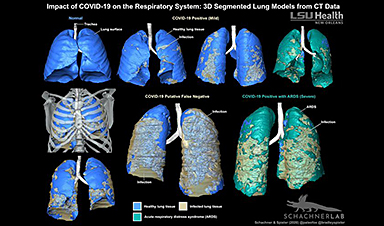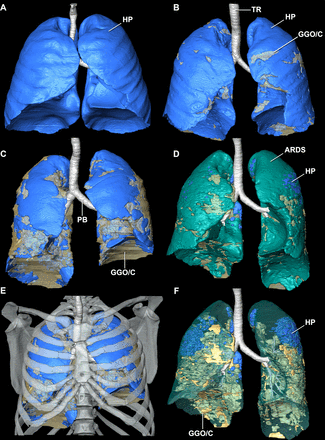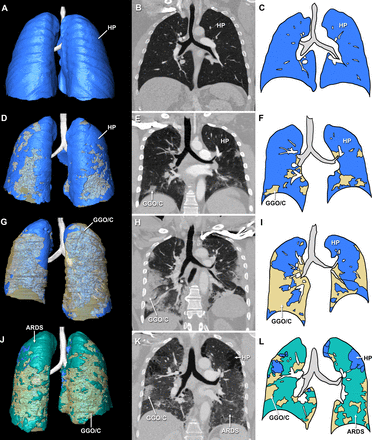Images Description
Three individuals were admitted to the hospital (ages 46–56; to men and one woman) with a multiday history of symptoms associated with the severe acute respiratory syndrome coronavirus 2 (SARS-CoV-2) and underwent contrast-enhanced thoracic CT due to worsening symptomatology. Three-dimensional (3D) digital models were created to visualise the extent of the disease within the respiratory system (figures 1 and 2) from the thin section (1 mm) data sets. All patients presented emergently with variable pulmonary symptoms ranging from mild to severe, including shortness of breath and all were febrile. Two of the patients were reverse transcription polymerase chain reaction (RT-PCR) positive for SARS-CoV-2 (figure 1B,D,F; figure 2C,D,G,H). The third patient was RT-PCR negative for SARS-CoV-2, but this was presumed to be a false-negative result given compelling clinical and imaging features indicative of COVID-19 (figures 1C,E and 2E,F). A fourth patient who presented to the emergency department and was suspected of having COVID-19 also underwent CT to assess for the possibility of pulmonary embolus (figures 1A and 2A,B). This individual tested negative for SARS-CoV-2, and the lungs were normal. All CT examinations were obtained using a Philips iCT 256 or iQon Spectral CT systems. Data were acquired using a 128×0.625 mm or 64×0.625 mm detector configuration with dual sampling, rotation time of 0.33 s (120 kVp 72 mAs).
Figure 1
Three-dimensional segmented surface models of normal, COVID-19 and suspected COVID-19 lungs in anterior view. (A) Healthy lung model of a 50-year-old man. (B) Lung model of a COVID-19-positive 46-year-old man with mild respiratory symptoms. (C) Lung model of a COVID-19-negative 56-year-old man with clinical suspicion for COVID-19. (D) Lung model of a COVID-19-positive 55-year-old woman with severe respiratory symptoms and ARDS. (E) C with a skeleton. (F) D but with the ARDS tissue made translucent to demonstrate the full extent of the ground glass opacities and consolidation throughout the parenchyma. ARDS, acute respiratory distress syndrome; C, consolidated infection; GGO, ground-glass opacities; HP, healthy parenchyma; PB, primary bronchus; TR, trachea. Colour key: blue, healthy tissue; yellow, consolidation and ground glass opacities; green, ARDS.
Figure 2
Three-dimensional (3D) segmented surface models of normal, COVID-19 and suspected COVID-19 lungs in posterior view (left) and coronal views with accompanying simplified diagrammatic illustrations of the coronal CTs demonstrating the infection sites. Healthy lungs of a 50-year-old man as a segmented 3D model in posterior view (A), a coronal contrast enhanced CT slice (B) and a diagrammatic illustration of B (C). COVID-19-positive 46-year-old man (mild respiratory symptoms) as a segmented 3D model in posterior view (D), a coronal contrast enhanced CT slice (E) and a diagrammatic illustration of E (F). Lungs of a COVID-19-negative 56-year-old man with clinical suspicion for COVID-19 as a segmented 3D model in posterior view (G), a coronal contrast-enhanced CT slice (H) and a diagrammatic illustration of H (I). Lungs of a COVID-19-positive 55-year-old woman with ARDS as a segmented 3D model in posterior view (J), a coronal contrast enhanced CT slice (K) and a diagrammatic illustration of K (L). Models demonstrate the relationship, distribution and full extent of the disease in 3D versus the single CT slice which only provides information on the localised position of the infection. ARDS, acute respiratory distress syndrome; C, consolidated infection; GGO, ground-glass opacities; HP, healthy parenchyma. Colour key: blue, healthy tissue; yellow, consolidation and ground glass opacities; green, ARDS. Images not to (relative) scale.
Image Credit: BMJ
News This Week
Johns Hopkins Researchers Uncover a New Way To Kill Cancer Cells
A new study reveals that blocking ribosomal RNA production rewires cancer cell behavior and could help treat genetically unstable tumors. Researchers at the Johns Hopkins Kimmel Cancer Center and the Department of Radiation Oncology and Molecular [...]
AI matches doctors in mapping lung tumors for radiation therapy
In radiation therapy, precision can save lives. Oncologists must carefully map the size and location of a tumor before delivering high-dose radiation to destroy cancer cells while sparing healthy tissue. But this process, called [...]
Scientists Finally “See” Key Protein That Controls Inflammation
Researchers used advanced microscopy to uncover important protein structures. For the first time, two important protein structures in the human body are being visualized, thanks in part to cutting-edge technology at the University of [...]
AI tool detects 9 types of dementia from a single brain scan
Mayo Clinic researchers have developed a new artificial intelligence (AI) tool that helps clinicians identify brain activity patterns linked to nine types of dementia, including Alzheimer's disease, using a single, widely available scan—a transformative [...]
Is plastic packaging putting more than just food on your plate?
New research reveals that common food packaging and utensils can shed microscopic plastics into our food, prompting urgent calls for stricter testing and updated regulations to protect public health. Beyond microplastics: The analysis intentionally [...]
Aging Spreads Through the Bloodstream
Summary: New research reveals that aging isn’t just a local cellular process—it can spread throughout the body via the bloodstream. A redox-sensitive protein called ReHMGB1, secreted by senescent cells, was found to trigger aging features [...]
AI and nanomedicine find rare biomarkers for prostrate cancer and atherosclerosis
Imagine a stadium packed with 75,000 fans, all wearing green and white jerseys—except one person in a solid green shirt. Finding that person would be tough. That's how hard it is for scientists to [...]
Are Pesticides Breeding the Next Pandemic? Experts Warn of Fungal Superbugs
Fungicides used in agriculture have been linked to an increase in resistance to antifungal drugs in both humans and animals. Fungal infections are on the rise, and two UC Davis infectious disease experts, Dr. George Thompson [...]
Scientists Crack the 500-Million-Year-Old Code That Controls Your Immune System
A collaborative team from Penn Medicine and Penn Engineering has uncovered the mathematical principles behind a 500-million-year-old protein network that determines whether foreign materials are recognized as friend or foe. How does your body [...]
Team discovers how tiny parts of cells stay organized, new insights for blocking cancer growth
A team of international researchers led by scientists at City of Hope provides the most thorough account yet of an elusive target for cancer treatment. Published in Science Advances, the study suggests a complex signaling [...]
Nanomaterials in Ophthalmology: A Review
Eye diseases are becoming more common. In 2020, over 250 million people had mild vision problems, and 295 million experienced moderate to severe ocular conditions. In response, researchers are turning to nanotechnology and nanomaterials—tools that are transforming [...]
Natural Plant Extract Removes up to 90% of Microplastics From Water
Researchers found that natural polymers derived from okra and fenugreek are highly effective at removing microplastics from water. The same sticky substances that make okra slimy and give fenugreek its gel-like texture could help [...]
Instant coffee may damage your eyes, genetic study finds
A new genetic study shows that just one extra cup of instant coffee a day could significantly increase your risk of developing dry AMD, shedding fresh light on how our daily beverage choices may [...]
Nanoneedle patch offers painless alternative to traditional cancer biopsies
A patch containing tens of millions of microscopic nanoneedles could soon replace traditional biopsies, scientists have found. The patch offers a painless and less invasive alternative for millions of patients worldwide who undergo biopsies [...]
Small antibodies provide broad protection against SARS coronaviruses
Scientists have discovered a unique class of small antibodies that are strongly protective against a wide range of SARS coronaviruses, including SARS-CoV-1 and numerous early and recent SARS-CoV-2 variants. The unique antibodies target an [...]
Controlling This One Molecule Could Halt Alzheimer’s in Its Tracks
New research identifies the immune molecule STING as a driver of brain damage in Alzheimer’s. A new approach to Alzheimer’s disease has led to an exciting discovery that could help stop the devastating cognitive decline [...]























